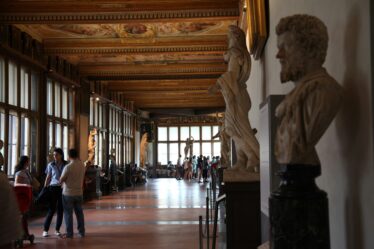

A Cosmic Vision Inside Brunelleschi’s Dome
The Last Judgment Florence is not only a painting — it’s a vision that defies time, space, and gravity.
Inside the Cathedral of Santa Maria del Fiore, beneath the monumental dome designed by Filippo Brunelleschi, unfolds the largest mural painting in the world: a breathtaking fresco of 3,600 square meters, conceived by Giorgio Vasari and completed by Federico Zuccari between 1572 and 1579.
This immense fresco depicts the Last Judgment, a theme of divine justice and human destiny, rendered with theatrical power and cosmic ambition.
(You can learn more about the Dome and its construction on the Opera del Duomo official site.)
The Birth of a Monumental Fresco
The Last Judgment Florence began as a bold commission to Giorgio Vasari, a leading Mannerist painter and art historian. His concept was grand: seven concentric circles rising toward the lantern, populated by more than 700 figures — angels, saints, demons, and the souls of the saved and the damned.
After Vasari’s death in 1574, Federico Zuccari took over, transforming the fresco into an even more dramatic vision. His brush emphasized the tormented expressions of the damned and the radiant serenity of the blessed, adding a sense of cinematic tension that anticipates Baroque sensibilities.
Each section of the dome tells a separate story, yet all converge into one apocalyptic symphony: the end of the world, painted high above the faithful.
(For Vasari’s biography and his role in Renaissance art, visit Uffizi Galleries’ Vasari profile.)
A Theater of Heaven and Hell
At the very center of the Last Judgment Florence, Christ the Judge reigns supreme, surrounded by Mary, John the Baptist, and hosts of angels.
Below Him unfolds the eternal drama — the blessed rising in spirals of light, while the damned fall screaming into darkness. The fresco bursts with movement, emotion, and symbolism: the seven deadly sins, archangels, and infernal beasts populate a composition both terrifying and sublime.
Through every curve of the dome, the viewer senses the moral gravity and the celestial order that defined Renaissance theology. It’s not merely art — it’s a vision of eternity painted on air.
(Explore a detailed guide to the fresco on Visit Florence.)
Technique, Vertigo, and Vision
But how was the Last Judgment Florence physically created on such an impossible surface?
The frescoes were executed on wet plaster (intonaco fresco), directly on the interior shell of the dome — more than 90 meters above the ground. Artists worked from suspended scaffolding, balancing between heaven and earth, surrounded by dust, lime, and vertigo.
This daring approach required not only artistic mastery but also architectural ingenuity. Every stroke was a gamble against gravity. The result merges mathematical precision, theological depth, and Renaissance emotion into a single breathtaking whole.
(Discover more about Brunelleschi’s revolutionary dome structure on Wikipedia – Brunelleschi’s Dome.)
Climbing Toward the Last Judgment
Today, visitors can climb the 463 steps to the summit of Brunelleschi’s Dome. Along the ascent, you can come face to face with Vasari and Zuccari’s masterpiece: the details, expressions, and muscular forms that still pulse with divine energy.
It feels like stepping into a cosmic theater, where every soul, angel, and demon plays an eternal role in the grand drama of salvation.
Here, art meets architecture, heaven meets earth, and time meets eternity.
At the top, as Florence spreads out beneath you, one realizes that the Last Judgment Florence is not only the largest fresco in the world but also a monument to human imagination — a triumph of faith, intellect, and artistic daring.
A Legacy Beyond Time
The Duomo of Florence stands as the city’s most recognizable landmark, and its dome remains the largest brick structure ever built. Yet, what lies within — this apocalyptic fresco of the Last Judgment Florence — transforms it into something even greater:
a cathedral of vision, a testament to humanity’s eternal quest to reach the divine.
And as the story closes, one might recall the Florentine saying:
“But that, as always, is another story.”



